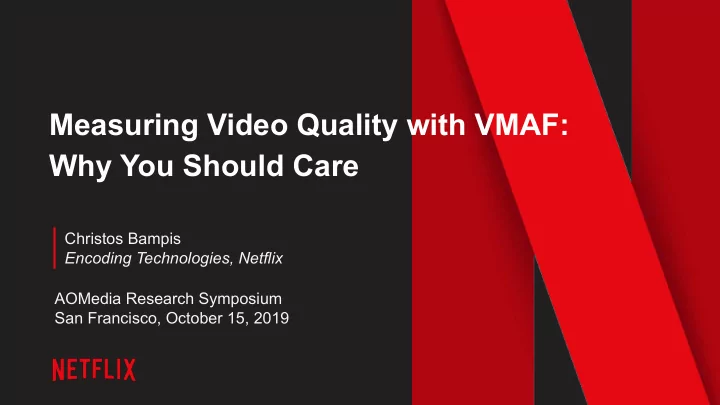

Measuring Video Quality with VMAF: Why You Should Care Christos Bampis Encoding Technologies, Netflix AOMedia Research Symposium San Francisco, October 15, 2019
Overview ● history and introduction to VMAF ● adoption ● challenges ● why is VMAF becoming more useful?
Need a better perceptual metric PSNR 29.1 dB PSNR 29.3 dB 19 Humans 69
VMAF ● accurately measures human perception of video quality ● consistent across content ● works well for picture artifacts relevant to adaptive streaming ○ compression artifacts ○ scaling artifacts ● open-source! VMAF : V ideo M ultimethod A ssessment F usion
The VMAF chronicle Speed optimization; added Started Started First public VMAF 0.6.1 published; a 4K model; added collaboration collaboration showing at ICIP added a phone model confidence interval with USC with UT Austin 2014 2015 2016 2017 2018 2019 First VMAF VMAF-enabled Speed VMAF went live on Github; running in video optimization optimization first VMAF techblog published prod @ Netflix in prod @ Netflix Started libvmaf published; VMAF collaboration supported by FFmpeg with U. Nantes
VMAF framework human visual system Pixel Neighborhood Frame Level (HVS) modeling: spatial feature simulate low-level within-frame extraction neuro-circuits spatial pooling (VIF, DLM) temporal feature temporal extraction (TI) pooling training with SVM trained per-frame score subjective data model prediction “Fusion”
HVS modeling: contrast masking ● One signal (e.g. compression artifacts) becomes more difficult to be detected by human eye when it is superimposed on another masker signal (e.g. the pristine source) of similar spatial frequency and orientation masking [Source: HDR-VDP2, Mantiuk et al. 2011]
VMAF framework Pixel Neighborhood Frame Level spatial feature within-frame extraction spatial pooling (VIF, DLM) temporal feature temporal extraction (TI) pooling training with SVM trained per-frame score subjective data model prediction Machine learning: “Fusion” align features with subjective scores
Lab test: collect subjective scores Bad Poor Fair Good Excellent Absolute Category Rating (ACR) Scale
Map ACR scale to VMAF scale Bad Poor Fair Good Excellent Absolute Category Rating (ACR) Scale VMAF Score 0 20 40 60 80 100 VMAF Scale True Score (ACR Scale)
Demo time!
VMAF adoption examples ● industry ● research community
Integration in 3rd-party tools
VMAF in codec comparisons BD-rate BD-rate BD-rate Resolution (PSNR) (VMAF) (MOS) HD -31.24% -35.18% -36% UHD -34.42% -40.44% -40% [Source: JVET-O0451 Subjective Comparison of VVC and HEVC, JVET 15th meeting: Gothenburg, SE, 3–12 July 2019]
VMAF in research papers
What are the challenges? ● design dimensionality ● dealing with noise codecs SDR/HDR resolution
Design dimensionality increased number of dimensions: ● different encoders: H.264/AVC, HEVC, VP9, AV1 ● SDR vs. HDR, dark vs. bright scenes ● different viewing conditions (phone vs. TV, 1080 vs. 4K) ● key question: how to design a model that is extensible and consistent?
Dealing with noise ● VMAF underpredicts under noisy source ● assess film-grain synthesis tools (e.g. AV1) source denoise encode decode add noise noise model
Why is VMAF becoming more useful? ● newer codecs (e.g. AV1) add more perceptual tools to their arsenal and PSNR is not enough to evaluate them ● open-source and well-adopted: problems are easier to find ● we are committed to further improving VMAF’s accuracy and speed
Summary ● VMAF aims to fill the gap in perceptual video quality metrics ● adopted by industry and academia, but there is room for improvement ● becomes more relevant for new and future codecs (AV1, AV2), e.g., for codec comparison, encoding optimization
Questions?
Recommend
More recommend